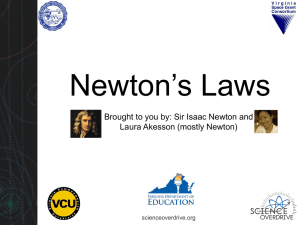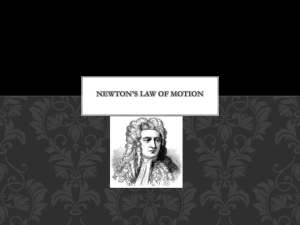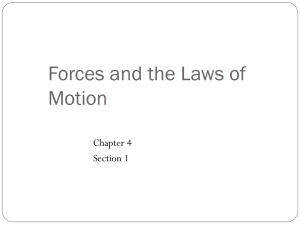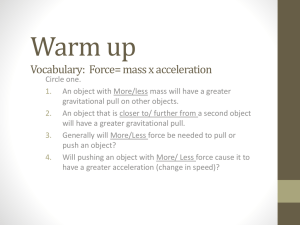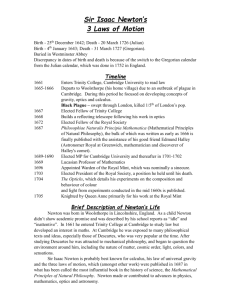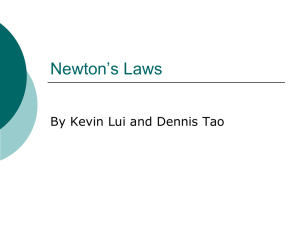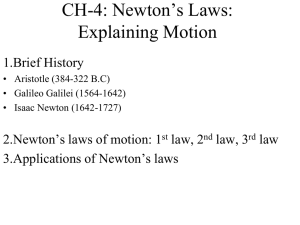NOTES- Newton`s Laws of Motion from Activities
advertisement
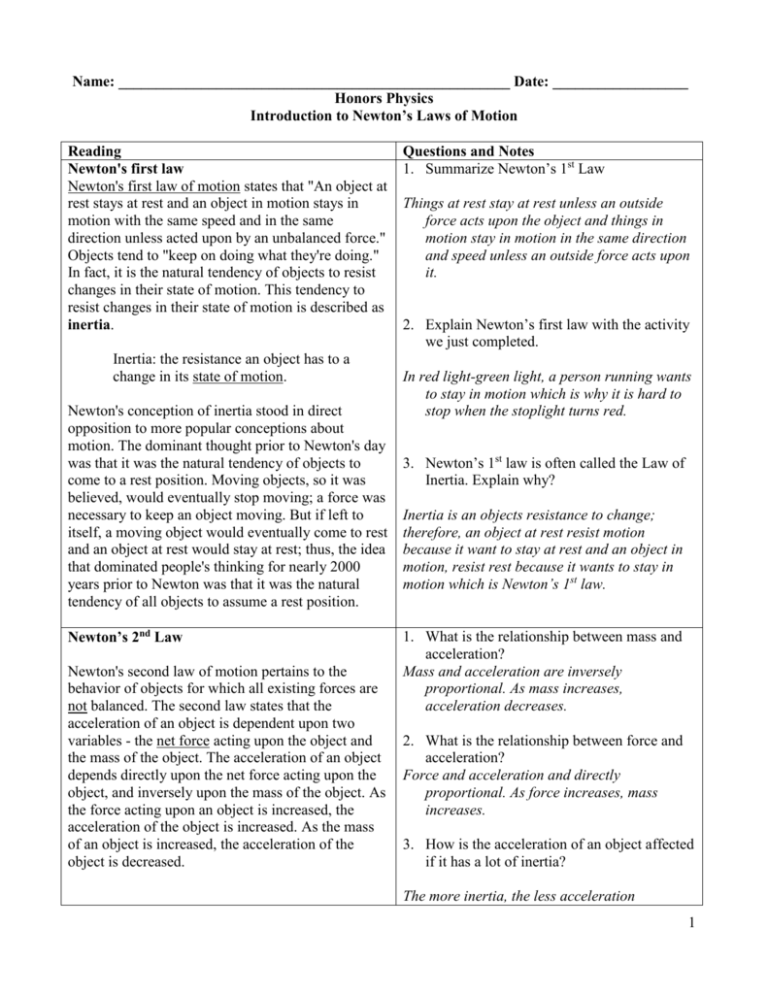
Name: ____________________________________________________ Date: __________________ Honors Physics Introduction to Newton’s Laws of Motion Reading Newton's first law Newton's first law of motion states that "An object at rest stays at rest and an object in motion stays in motion with the same speed and in the same direction unless acted upon by an unbalanced force." Objects tend to "keep on doing what they're doing." In fact, it is the natural tendency of objects to resist changes in their state of motion. This tendency to resist changes in their state of motion is described as inertia. Inertia: the resistance an object has to a change in its state of motion. Newton's conception of inertia stood in direct opposition to more popular conceptions about motion. The dominant thought prior to Newton's day was that it was the natural tendency of objects to come to a rest position. Moving objects, so it was believed, would eventually stop moving; a force was necessary to keep an object moving. But if left to itself, a moving object would eventually come to rest and an object at rest would stay at rest; thus, the idea that dominated people's thinking for nearly 2000 years prior to Newton was that it was the natural tendency of all objects to assume a rest position. Newton’s 2nd Law Newton's second law of motion pertains to the behavior of objects for which all existing forces are not balanced. The second law states that the acceleration of an object is dependent upon two variables - the net force acting upon the object and the mass of the object. The acceleration of an object depends directly upon the net force acting upon the object, and inversely upon the mass of the object. As the force acting upon an object is increased, the acceleration of the object is increased. As the mass of an object is increased, the acceleration of the object is decreased. Questions and Notes 1. Summarize Newton’s 1st Law Things at rest stay at rest unless an outside force acts upon the object and things in motion stay in motion in the same direction and speed unless an outside force acts upon it. 2. Explain Newton’s first law with the activity we just completed. In red light-green light, a person running wants to stay in motion which is why it is hard to stop when the stoplight turns red. 3. Newton’s 1st law is often called the Law of Inertia. Explain why? Inertia is an objects resistance to change; therefore, an object at rest resist motion because it want to stay at rest and an object in motion, resist rest because it wants to stay in motion which is Newton’s 1st law. 1. What is the relationship between mass and acceleration? Mass and acceleration are inversely proportional. As mass increases, acceleration decreases. 2. What is the relationship between force and acceleration? Force and acceleration and directly proportional. As force increases, mass increases. 3. How is the acceleration of an object affected if it has a lot of inertia? The more inertia, the less acceleration 1 Newton's second law of motion can be formally stated as follows: The acceleration of an object as produced by a net force is directly proportional to the magnitude of the net force, in the same direction as the net force, and inversely proportional to the mass of the object. This verbal statement can be expressed in equation form as follows: a = Fnet / m The above equation is often rearranged to a more familiar form as shown below. The net force is equated to the product of the mass times the acceleration. 4. If an object has a lot of inertia, what must one do in order to increase the acceleration? Apply a lot of force! 5. How does Newton’s 2nd law relate to the activity completed in class? The softball had less mass; therefore, did not need as much force to accelerate. The dodge ball had more mass which required more force to accelerate Fnet = m * a Newton’s 3rd Law According to Newton, whenever objects A and B interact with each other, they exert forces upon each other. When you sit in your chair, your body exerts a downward force on the chair and the chair exerts an upward force on your body. There are two forces resulting from this interaction - a force on the chair and a force on your body. These two forces are called action and reaction forces and are the subject of Newton's third law of motion. Formally stated, Newton's third law is: For every action, there is an equal and opposite reaction. The statement means that in every interaction, there is a pair of forces acting on the two interacting objects. The size of the forces on the first object equals the size of the force on the second object. The direction of the force on the first object is opposite to the direction of the force on the second object. Forces always come in pairs - equal and opposite action-reaction force pairs. 1. What is the minimum number of forces that are present on an object at any given time? TWO because for every force there is an equal and opposite one. 2. If a piece of paper weighs 1 N (a measure of force) with how much force can you hit a piece of paper according to Newton’s 3rd law? I can only hit the paper 1 N because I can only hit the paper as hard as the paper can hit me back in order for the action and reaction to be equal and opposite. 3. Explain how Newton’s 3rd Law relates to the activity in class? As each person pushed on each other’s backs, the action-reaction was equal and opposite which is why similar sized people could stand up. 2

